|
Salvador Dali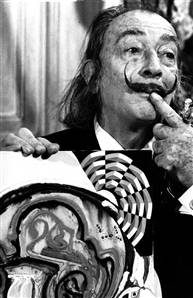 Salvador Dali was born in Spain in 1904 to a headless woman who kept track of her contractions with a melting wristwatch, in a half-finished room with an armless skeleton for a midwife.
Salvador Dali was born in Spain in 1904 to a headless woman who kept track of her contractions with a melting wristwatch, in a half-finished room with an armless skeleton for a midwife.Well, maybe not, but you wouldn't know it from looking at his life. Salvador Dali apparently led a perfectly normal childhood, albeit the perfectly normal childhood of a artistic prodigy. In other words, he was spoiled and tempermental, but not obviously the raving loon that would emerge in his later life. He began to draw and paint at an early age. It was an exciting time to be an artist, as painters like Pablo Picasso were tearing down the old conventions of realism in favor of time-bending Cubism and the young movement of Surrealism. Dali seized the latter for his own, and the world was never quite the same.
Instead of depicting scenes of reality enhanced through creative distortion and subtle manipulation, as the Impressionists had, Dali and his contemporaries sought to capture emotional states using archetypical symbols and dream imagery. The results were often astounding, and often astoundingly disturbing. As a teenager learning a trade, Dali's still lifes and landscapes had been competent but somewhat uninspired. By the time he was a young man, however, his signature style began to emerge in works like "Girl with Curls" and "Girl in the Window."
Dali's work succeeded in large part because he seamlessly melded the most bizarre imaginings with an often photorealistic style of painting, with the result that even the most outrageous scenes had a weight and reality that few traditional artists could achieve even when painting directly from life. His use of shading and color often made his images leap off the canvas, imbuing an astonishing amount of depth onto a two-dimensional surface. In Paris, Dali met the love of his life, more or less -- a woman named Gala. After extracting her from her previous relationship, Dali took her to his heart and put her in charge of his business operations. Like Andrew Wyeth painting his neighbor Helga, Dali painted Gala dozens on dozens of times. Unlike Wyeth, Dali spiced up his variations on a theme with various mythical figures, orbiting spheres, Abraham Lincoln, and various adult situations. Dali and Gala came to America to show his work. The artist was entranced with America, and wrote bizarre prose poems to its phallic monuments. "New York, you are an Egypt! But an Egypt turned inside out. For she erected pyramids of slavery to death, and you erect pyramids of democracy with the vertical organ-pipes of your skyscrapers all meeting at the point of infinity of liberty!"
"The Enigma of William Tell" managed to offend even Dali's fellow Surrealists, with its depiction of raw meat slung over Lenin's elongated right buttock. Because, you see, the other Surrealists liked Lenin and Communism, while Dali favored Hitler and Fascism (despite his giddiness over the "pyramids of democracy"). And the elongated buttock, in case you were unclear on the concept, was considered disrespectful to Lenin. Or something like that. Dali's fascination with Hitler was predictably problematic in pre-World War II America. The artist told a biographer, "I saw Hitler as a masochist obsessed with the idee fixe of starting a war and losing it in heroic style. In a word, he was preparing for one of those actes gratuits which were then highly approved of by our group."
The strife over Hitler eventually led Dali to break with the other Surrealists, who were incongruously conformist among their own peer group. Dali's work progressed on several fronts. He also began working with the image of melting clocks, which became a recurring theme in works like "The Dream of Venus," and "The Persistence of Memory," his most famous work. He produced a series of stereoscopic images that explored his fascination with depth and perspective. They were unlike anything seen before or since: Viewmaster slides with a messiah complex.
In 1945, Alfred Hitchcock made the classic thriller Spellbound, for which Dali designed a series of hallucinatory dream sequences that allow the protagonists to unlock the movie's secrets through psychoanalysis. Dali had wanted to cover Ingrid Bergman in ants for one of the scenes. It's not entirely clear whether that was motivated by art or simply for perverted kicks. Either way, Bergman declined. Less memorably, Dali contributed a dream sequence to the 1950 romantic comedy "Father of the Bride." In 1936, legend has it, Dali met Harpo Marx and struck up a friendship. That year, he sent Harpo a Christmas present -- a harp with strings made of barbed wire. The encounter inspired Dali to write a script for the Marx Brothers. According to Harper's Magazine: The film, entitled Giraffes on Horseback Salads, was never made, reportedly because MGM, which had an exclusive contract with the Marx Brothers, felt it was too surreal. The script, which Dali wrote in English, was recently discovered among Dali's papers; it is owned and was made available by the Fundació Gala-Salvador Dalí in Figueres, Spain. Apart from roles for the Marx Brothers, the script includes a character called the 'Surrealist woman' and a Spanish businessman named Jimmy. 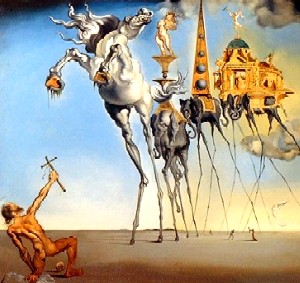 By now, Dali had established four major artistic themes, which would form the core of his work for the rest of his career: masturbating, enigmas, Gala, and melted clocks. The images were produced using what he called the "paranoiac critical" method, which Dali explained as a "spontaneous method of irrational knowledge based on critical and systematic objectivation of delirious associations and interpretations."
By now, Dali had established four major artistic themes, which would form the core of his work for the rest of his career: masturbating, enigmas, Gala, and melted clocks. The images were produced using what he called the "paranoiac critical" method, which Dali explained as a "spontaneous method of irrational knowledge based on critical and systematic objectivation of delirious associations and interpretations." The paranoiac-critical method was simple. The artist tricks himself into going insane, while somewhere deep within remembering that the reason for the insanity is to create a great work of art. Dali chose to do it the hard way -- by actually going mad, rather than simulating madness through chemical means. "I don't take drugs. I am drugs," he once explained. A theologian could have a field day wondering about God's paranoiac-critical approach to creating the world. The psychiatrist may wonder what might be the difference between pretending to be completely insane while secretly knowing you aren't, and actually being completely insane and secretly holding the delusional belief that you aren't. (Dali himself once explained this by writing, "There is only one difference between a madman and me. I am not mad.") The cultural observer simply contents himself with noting that this "method" provided Dali with a good excuse to do whatever the fuck he felt like, all in the name of art.
By the 1950s, Dali was more of a gadabout than a traditional artist. He appeared on TV game shows such as "What's My Line?" where he engaged in good natured, if somewhat bizarre, banter with his fellow guests. He did commercials for Alka Seltzer and designed hats shaped like lobsters. He designed furniture, took up sculpture, created perfumes, wrote PR copy and even briefly worked as a hairdresser. When he did bother to produce paintings, they were still brilliant, such as the 1954 work, "The Temptation of St. Anthony." Dali also produced one of the most revered Tarot decks in the history of that medium: 78 fully painted cards which combined dream imagery with kabbalist symbolism. And, of course, some stuff that was just plain weird. Unlike many of the greatest artists in history, Dali was a financial success, which may have been a bigger factor than Hitler in his alienation from the other Surrealists. Thanks in equal part to the smart management of Gala and his willingness to prostitute himself for a payday, Dali amassed a fortune sufficient to indulge his eccentricities in grand style. In later life, he purchased a castle in the town of his birth. The castle housed a museum in his honor. Dali spent the last months of his life living in its tower, where he died in 1989.
|
 The artistic influences flowing into Dali's work were filtered through the new science of psychoanalysis. Dali was one of the first creative minds to realize the potential that
The artistic influences flowing into Dali's work were filtered through the new science of psychoanalysis. Dali was one of the first creative minds to realize the potential that 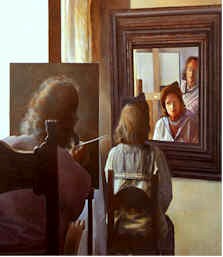 By the time of "The Lugubrious Game" in 1929, Dali had arrived in Paris and on the scene. The painting is like Cubism on crack, images telescoping through time and perspective, but also through various degrees of strange and murky distortion, presaging the animations of
By the time of "The Lugubrious Game" in 1929, Dali had arrived in Paris and on the scene. The painting is like Cubism on crack, images telescoping through time and perspective, but also through various degrees of strange and murky distortion, presaging the animations of 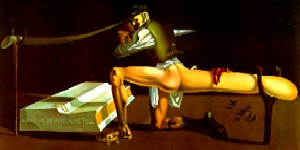 Uh... yeah! Dali and America got along famously. At first, it was a spur to his creativity, leading to a prolific period in which he produced "The Old Age of William Tell" and "Autumn Cannibalism."
Uh... yeah! Dali and America got along famously. At first, it was a spur to his creativity, leading to a prolific period in which he produced "The Old Age of William Tell" and "Autumn Cannibalism." 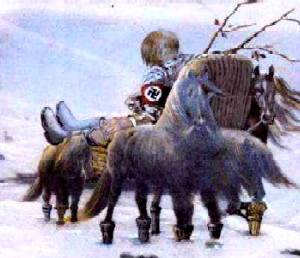 As you can clearly see, Dali was fascinated with Hitler because of... of... well, for some fucking reason. This led to a series of paintings bashing Lenin and, uh, let's go with "celebrating" Hitler, including "The Engima of Hitler" and "Hitler Masturbating." (Dali once said the
As you can clearly see, Dali was fascinated with Hitler because of... of... well, for some fucking reason. This led to a series of paintings bashing Lenin and, uh, let's go with "celebrating" Hitler, including "The Engima of Hitler" and "Hitler Masturbating." (Dali once said the 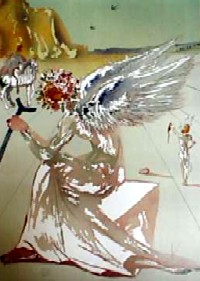 Dali also made forays into film, most notably in Un Chien Andalou, a short surrealist film made with Luis Bunuel which famously features the image of an eyeball being cut open by a straight razor. (The effect was mimicked using clever editing and a cow's eye.)
Dali also made forays into film, most notably in Un Chien Andalou, a short surrealist film made with Luis Bunuel which famously features the image of an eyeball being cut open by a straight razor. (The effect was mimicked using clever editing and a cow's eye.) 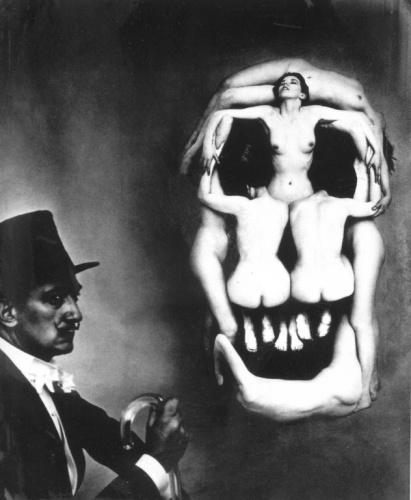 Dali made good use of paranoiac-critical rationalization, and he slowly transitioned from being a full-time painter who also happened to be a minor celebrity, to being a full-time celebrity who also managed to create the occasional painting.
Dali made good use of paranoiac-critical rationalization, and he slowly transitioned from being a full-time painter who also happened to be a minor celebrity, to being a full-time celebrity who also managed to create the occasional painting.